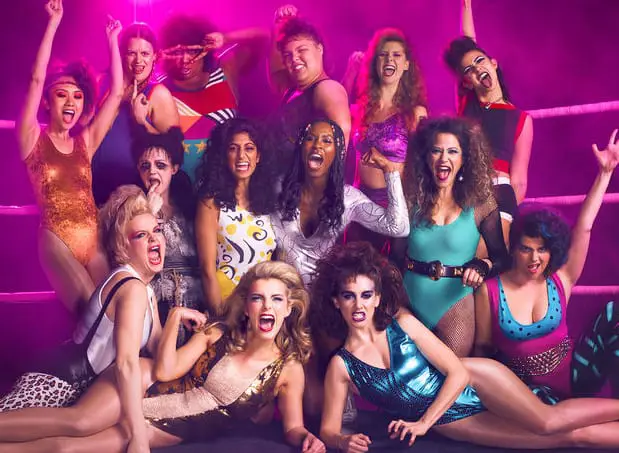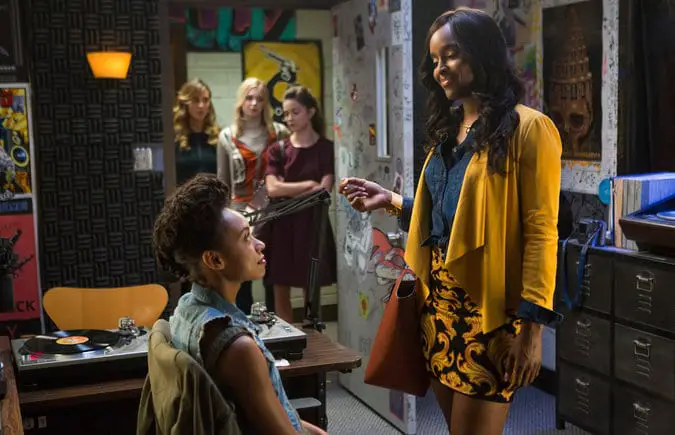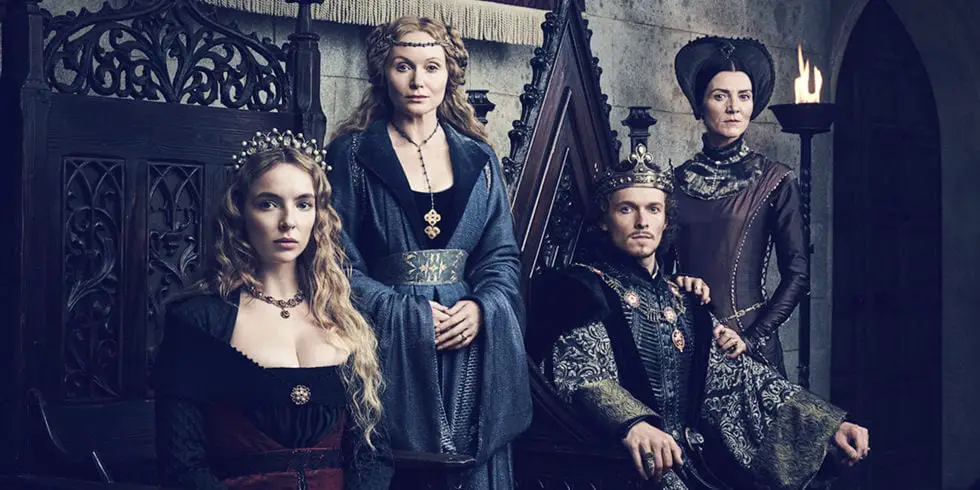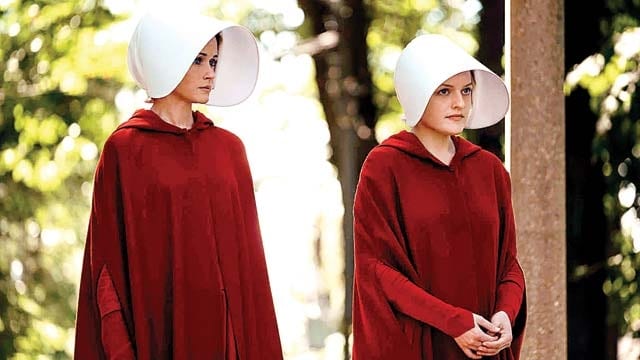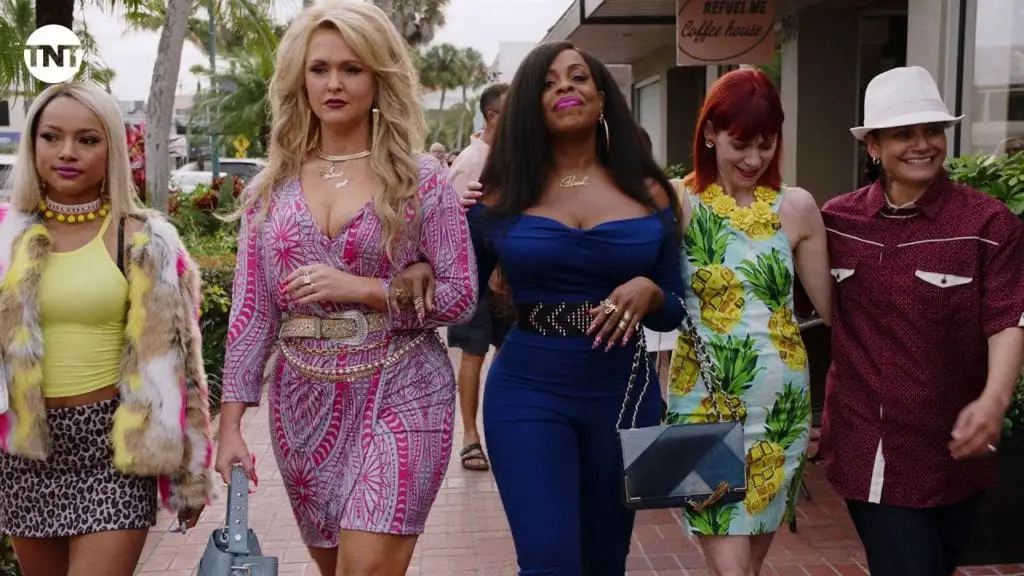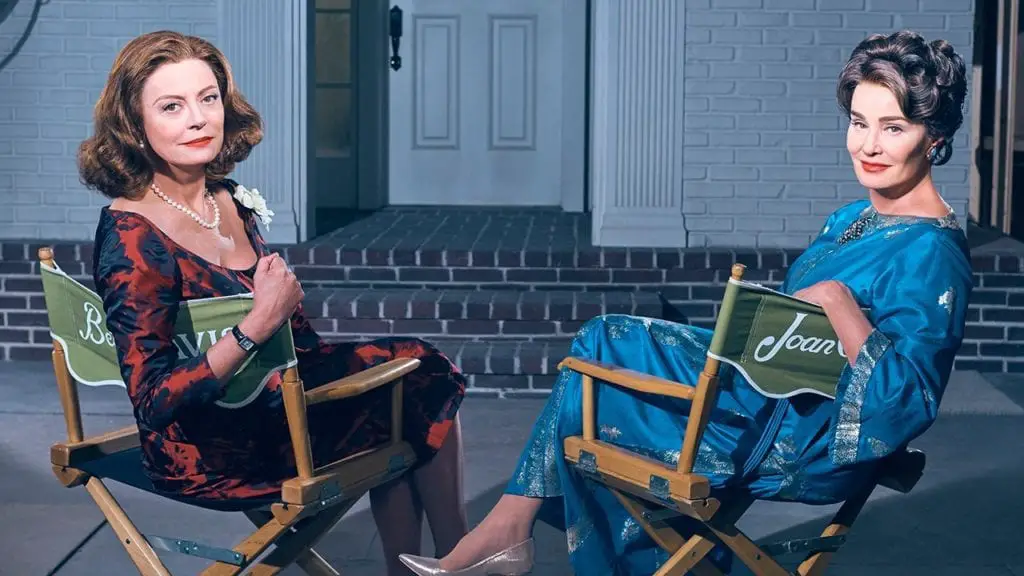Shockingly enough, we just passed the halfway mark of 2017 so I felt this could be an opportunity to shed some light on a few TV shows I personally thought showed some initiative on writing more complex and well-rounded female roles. Admittedly, this list is not nearly as diverse as I would have preferred. In terms of themes, fortunately, female friendship is back on the agenda, and I’m really excited to see even more of it in the future.
So, here are a couple of English-speaking TV Shows that premiered in 2017 — debut only — that got this reviewer’s Stamp of Approval to varying levels.
Content warning: discussion of sensitive topics as portrayed by the shows as well as mild-to-heavy spoilers.
Glow
Released not even two weeks ago on Netflix, Glow tells the story of the Gorgeous Ladies of Wrestling. The show is anchored by Community‘s Alison Brie and Elementary‘s Betty Gilpin, but we are actually talking about a cast made up of 14 women playing wrestlers with different complexions, ethnicities, body shapes (so far and very sadly, neither of them have identified themselves as wlw).
The plot is about Brie’s Ruth, a “serious actress” who after an extended time suffering in the hands of Hollywood, gets thrown into GLOW (it’s a show within a show type of deal). Her former best friend, Gilpin’s Debbie, also gets a part on the production, causing friction, but I’d call it a safe bet that, with so many female characters working for the common goal of being wrestlers, friendship will most likely win in the end.
Glow is not only one of the most female shows on camera currently out there, but also behind it: it was developed by Liz Flahive and Carly Mensch while being executive produced by Jenji Kohan from Weeds and Orange Is The New Black. Plus, six of the ten episodes released were directed by women which is a trend that is only getting more steam lately and we are all fully behind it! Oh, and an extra tidbit: not only a lot of professional wrestlers have cameos, but Kia Stevens, who has fought in WWE is one of the main actors of the show.
Dear White People
After an incident with blackface at the Winchester University campus, biracial outspoken student Samantha White (Logan Browning) takes it to her “Dear White People” podcast to incite conversation on the huge white elephant in the room: racism is still very much alive which, shockingly, is shocking to some people. Sam has the help of her friends and boyfriend in a show that, even as I binged it very recently and I consciously know it was filmed months and months ago, feels like something that could have been written just earlier today: for example, the show even mentions Philando Castile’s case which gathered new focus on the media barely a few days ago.
Besides an on-point drama about the difficulties faced by black people, the show is hilarious and extremely quotable — plus, I can’t consciously even come up with reasons to dislike a show that drags Game of Thrones for hiring Black actors for slave roles only. Also, I legit screamed when they dragged Tarantino for its overbearing fetishization of the n-word in his period movies *while* looking straight at the camera. There’s also quite the focus on the whole “don’t say the n-word if you’re white and you like rap” which was fantastic even if it ended in a tragic situation that had me completely on edge — the show can be just as serious when dealing with racism as it can be light when satirizing it and there’s no whiplash because you really care for it.
The White Princess
If you are looking for reasons to dislike The White Princess, our contributor Anne has already broken down how its historical inaccuracy and faux-feminism undermines what the show wanted to stand for (plus, some really great discussion goes down in the comment section, so make sure to check it out). Personally, the historical issues didn’t quite bother me because I really did suck at history (STEM major problems, am I right?) and some of the faux-feminism even convinced me about the show’s “quality”: the showrunner Emma Frost, for example, wanted to avoid the Sansa Stark dilemma by turning a rape into a “I am being forced to have sex, so I’ll take agency in it and make sure the other person hates it as much as I do because our parents are making us do it”, which was…a nice intention at the very least.
However, further look proves that, in the end, the really consistent thing The White Princess delivered is acting. The show is headlined by Jodie Comer, who you might recognize for My Mad Fat Diary, Essie Davis, known for the gay icon movie The Babadook (Happy Pride Month!), Miss Fisher’s Murder Mysteries, and even a brief stint in our ever-so-unpleasant Game of Thrones as Lady Crane, and finally Michelle Fairley, who is once again playing the role of “The King’s Mother With Relative Political Influence” — oh oh, has Fairley been a victim of typecasting?
13 Reasons Why
If you want a show that not only is diverse, but shrouded in controversy, 13 Reasons Why is your pick, but a fair warning to those of us who deal with triggers. Despite its non-debatable issues (the biggest one is the ultimate romanticization of suicide and its graphic scene), this show wrecked me emotionally in the sense that I found myself deeply attached to the characters. Katherine Langford is the name to watch in the show as she wonderfully portrays the high school student Hanna Baker through all the traumas she endures — and, jeez, there are many of those.
American Gods
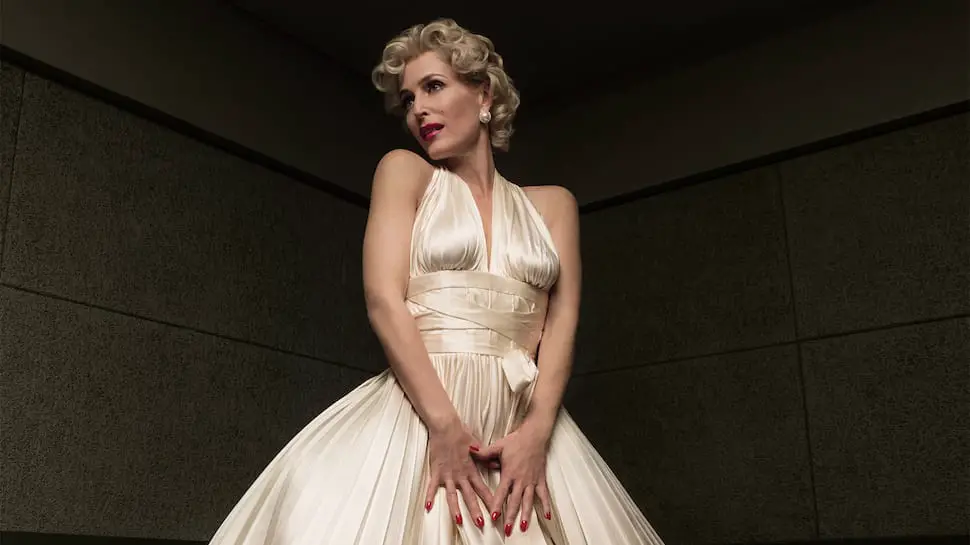
A lot has already been said here about the winning and losing points American Gods has scored throughout its eight weeks. Once again, Bryan Fuller and Michael Green got some amazing talent attached to their show in the names of Emily Browning, Yetide Badaki, Gillian Anderson, and Kristin Chenoweth.
Future prospects include even more female characters to the mix, including the infamous wlw Sam Black Crow and the Indian goddess Mama-Ji. Season 1, however, featured the spectacle that was Gillian as Media (well, four different aspects of Media anyway) and Emily as Laura Moon, back from the dead with new found motivation to stay alive — her solo backstory episode was one of the brightest of the pack and she even got to play a different character, Essie McGowan.
The Handmaid’s Tale
Before Hulu finally got its big break last April, it tried last March with Harlots, a show that I have read some good things about, but never really got around to watching. Finally, The Handmaid’s Tale came to intense critics and audience praise, warranting culture references in Saturday Night Live and even actual protests.
Having some issues streamlining the story and even focusing on the male issues (let’s call it “worldbuilding”), The Handmaid’s Tale is a show that will most likely make you shiver inside your skin. It’s brutal, it’s uncomfortable, it’s infuriating, and even makes you feel impotent upon watch such cruelty against women. Elizabeth Moss plays a different June/Offred from the book— from what I’ve read in reviews —, but she is still a vibrating, versatile, and commanding actor, going from the somewhat-silently oppressed Offred to the more outspoken June in a beat.
Alexis Bledel plays the wlw Emily/Ofglen in one of the most heartbreakingly tragic arcs of the semester in which she witnesses the brutalization of wlw while emoting without a single word. We also have Yvonne Strahovski playing Serena Joy, the dangerously-close-to-Phyllis Schlafly commander’s wife; Samira Wiley as June’s best friend Moira; Ann Dowd as yet another quite unlikeable boss-like-figure Aunt Lydia; and Madeline Brewer playing another handmaid, Janine.
Claws
After a scene-stealing stint on Scream Queens and even an Emmy nomination for Getting On, Niecy Nash commands an ensemble in the sex-positive Claws as a nail technician/beauty professional involved with a money laundry scheme against the world’s least likeable/most eye-rollable mobster, Uncle Daddy (yikes), played by Dean Norris, who keeps overusing the word “boy”. The cast is diverse featuring Scrubs‘s Judy Reyes playing a butch lesbian and mother, Carrie Preston, Karrueche Tran, and Jenn Lyon. So far, only four episodes have aired, but the show is definitely one to keep an eye on.
Feud: Bette and Joan
Before watching Feud: Bette and Joan, I don’t think I had even heard the names Joan Crawford and Bette Davis before. I had never heard of Whatever Happened To Baby Jane (WHTBJ). I didn’t even think much of the announcement of the show in 2016. And yet I was obviously going to watch it because, no matter how Ryan Murphy screwed up Glee and American Horror Story in multiple seasons, he had a track of handing in bright new shows and the exuberant American Crime Story: The People V. OJ Simpson is all the proof I needed. Plus, the attached talent of Jessica Lange and Susan Sarandon were big draw-ins.
As we like to say here, media and culture is neither crafted nor consumed in a vacuum: there is relevance to what we watch considering political, social, and economic climate. Jessica Lange herself said that when she was shooting Feud last year, she expected that, by the time it aired (March-April), we would take the show with a bit more optimism; however, it was not the case.
Bette and Joan delivered in eight solid episodes the famous drama between the legendary actors Bette Davis, played by Susan Sarandon, and Joan Crawford, played by Jessica Lange. The show started after much of the feud had taken place, but also at a critical point: the beginning of the production of WHTBJ, the only movie the two ever worked in together.
Whatever Happened To Baby Jane itself, as told by Feud (I still have not watched the movie) has a degree of meta-commentary: it’s a flick about two feuding sibling actors that end in tragedy. The production of the film was marked by Crawford and Davis going at it and trying to undermine each other as both actors navigated a Hollywood that wanted to shun mature and older women and bury them like a shameful secret. As the show narrates, WHTBJ was actually Crawford’s pitch and it was also her idea to invite Davis along for the sake of two commanding, tested, and struggling legends to be made “relevant” again.
Against all odds, WHTBJ proved to be both a box office and critical success. Crawford and Davis were expected to get Oscar nominations and even the director, Robert Aldrich, seemed to be back in his glory days. To complicate tense relationships, the Academy ended up nominating only Davis, infuriating Crawford who took it upon herself to sabotage her co-worker, creating a grand scheme in which Crawford herself would end up receiving the Oscars for Best Actress as she accepted in the absence of the actual winner, Anne Bancroft. The event is, by the way, along with the finale, the likely episodes that will be competing for the upcoming Awards season in the technical categories.
The finale tried to give the audience some closure in severely heartbreaking ways. One specific hallucination/vision montage told us what we wanted to hear all along: Crawford and Davis could have been friends. Not only that, but they should have been friends. Personally, it gave me such a feeling of impotence and hopelessness because it is so hard to see the wasted potential of friendship even if the two actors have passed away so many years ago (I myself wouldn’t even be born after almost a decade after Davis passed and two decades after Crawford’s). The finale took the show’s quasi-catchphrase “Feuds aren’t about hate — they are about pain” to the bank and broke me wholeheartedly.
Incidentally, Susan Sarandon mentioned how avid both the audience and the critics were to know whether she and Jessica Lange were friends. While I do believe that some of this avidness was because we still very much live in a culture where celebrities fighting is considered interesting, I also choose to have faith that we don’t want to live through another feud. We didn’t want to see another tragedy happening between such two actors we absolutely adore. Despite the still ongoing sexism, ageism, and misogyny that the show takes such good care in exploring, we needed to know whether we were better than before.
Thankfully, that seemed to be the case as Sarandon and Lange appear to have a good relationship and it warms my heart to see pictures of the two together laughing because, at this point in history, women supporting women is one of the things we need the most.
Big Little Lies
With the initial support of Reese Witherspoon, who has been vying for more complex roles for mature women, Big Little Lies (which shall absolutely NOT be compared or even put in the same category of Pretty Little Liars) is an adaptation of the Liane Moriarty book by HBO, with all of the episodes brilliantly directed by Jean-Marc Valleé.
The show tells the story of five moms played by Reese Witherspoon, Nicole Kidman, Shailene Woodley, Laura Dern, and Zoë Kravitz. The central premise of the show is the mysterious murder that happens at a masquerade ball: it’s a whodunit who really only revealed the who-died and who-killed in the last episode, taking us first and foremost through the lives of the Monterrey Moms.
Each of them has a different background and complexities (some more than others). Witherspoon plays a wife who is struggling with her second marriage and teenage daughter. Through mutual kindness, she takes Woodley, recently arrived at Monterrey, under her wing. Woodley herself is looking for a fresh start with her first grader son who was conceived when she was sexually assaulted years previously. Kidman plays Witherspoon’s best friend who is going through her own personal hell with an abusive husband played by Alexander Skarsgard. Laura Dern plays a sort of initially antagonist mom whose daughter is being bullied. Kravitz gets the bitter end (aka less screentime) portraying a yoga instructor who is Witherspoon’s first husband’s wife.
Out of all of these parts, I believe it’s safe to say that Nicole Kidman took the best and most grateful role. The way her character drives through a marriage that she wants to hold on to for the sake of her twin boys, but also has roots in both violent sex and violence itself played perfectly. There’s also the inclusion of a couple’s counselor who was highly praised by real-life therapists for the veracity of its portrayal.
In the end, Big Littles Lies looks like a foil to FX’s Feud in the sense that it, at the very least, shows female friendship instead of just a ‘what if’ scenario. I know that it’s pretty impossible to write a female-led TV show without fighting, intriguing, and some eye-rolling cattiness, but I do believe Big Little Lies walk the lines between friends and foes pretty neatly: you have Shailene complimenting Reese’s and Nicole’s beauty and mutual support among the trio, but also Reese being catty to Zoe and Laura. However, the show closes on unity, togetherness, and alliance so I guess it evens out.
So, About the Upcoming Awards Season…
Many of us consider the Emmys, Oscars, Grammys, and to a lesser extent the Golden Globes to be a complete sham — I mean, with less deserving shows (*cough* do I even need to name names here? *cough*) being shoved Emmys in Screenwriting and cardboards being nominated for the acting categories, I really don’t blame the Awards-detractors. However, I do have a soft spot for them. Last year, for example, despite some atrocious choices, the Emmys awarded long time favorite Tatianna Maslany and Sarah Paulson, so maybe not everything is lost just yet.
This year, however, may prove to be incredibly difficult. I mean, it is almost a certainty of mine that some of the actors I cited above are deadlocks for nominations, but, especially for the Emmys, we still have to take into consideration the second semester from 2016 which yielded favorite debuts such as The Crown, Westworld, and This is Us — without even mentioning the melange of other “obscure” low-rated shows that escape our watch by accident and the many returning shows each with their own amazing cast.
Thankfully, there’s some wiggle room given the six acting categories directed at women. Feud and Big Little Lies may compete against each other, which in itself will hurt when you have Jessica Lange, Susan Sarandon, and Nicole Kidman together (plus, maybe Reese Witherspoon, Shailene Woodley, and Catherine Zeta-Jones!). I believe Elizabeth Moss will get her own nomination and so will Alexis Bledel for The Handmaid’s Tale. For Westworld, I’m rooting for Evan Rachel Wood and Thandie Newton who has already been awarded last year for her role as Maeve at the Critics Choice Awards.
It’s pretty granted that Claire Foy, as the Golden Globe winner for The Crown, will also stand among the nominated. Glow and Claws will have to wait until next year (for the Emmy, at least) given their premiere dates in late June, but I think that, to a certain extent, both Alison Brie and Niecy Nash might get theirs as well. Sarah Paulson may do it again for her three roles in the latest season of American Horror Story.
I can also see Gillian Anderson in a supporting category and Logan Browning getting some love in the Comedy division. Katherine Langford is a bit more doubtful because we all know these “serious” awards avoid teenage shows, but I’m positive the other Choice Awards (Kids, Teen, People… you pick) will show the newcomer some love. While its predecessor The White Queen was present at both Golden Globes and Emmys, I am having some issues seeing The White Princess repeating the legacy.
Honorable Mentions
To conclude, I believe it is worth a mention the amazing job Aubrey Plaza did in Legion earlier this year as she took on a complex antagonistic role in the X-Men universe which probably means won’t get a lot of attention come Awards season. Lili Reinhart also managed to steal a lot of her scenes in Riverdale as Betty Cooper. From Netflix and despite some critics’ opinions, Drew Barrymore was the best part of the PTA-mom/Zombie complex that she portrayed in Santa Clarita Diet. Disrespecting my own rule, I feel the need to include Britt Marling’s performance from The OA who was released very late last year and both Mary Elizabeth Winstead’s and Carrie Coon’s roles for the third season of Fargo which is an anthology, so it could be seen as a debut.


